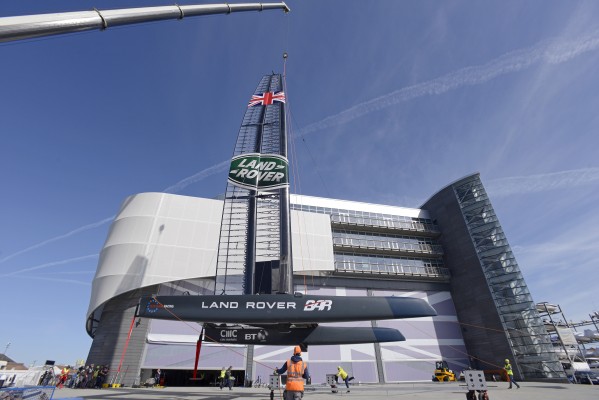The latest high-tech, high-secrecy design from British America's Cup Challengers Land Rover BAR was launched at the team base in Portsmouth earlier this month.
Land Rover BAR is the first of the America’s Cup Challengers to launch a third test boat, ‘T3’. With just over a year until the America’s Cup qualifying races begin (late May, 2017) the British team is keeping their cards close regarding the new design, which follows T2, the previous test platform launched in October last year.
Andy Claughton, Chief Technology Officer at Land Rover BAR, explains why they have built a third test boat. “T2 was really useful, we learned a huge amount, she’s played her part in the development programme and now we’re moving on.
“The rules are now better defined, and while the Challengers can only build one full-size ACC boat, all teams can build shorter versions of the ACC boat as test or development boats – so T3 looks very like the final race boat, just a few feet shorter.”
One of T3’s most distinctive features is the positioning of the rudders, which are hung aft of the hulls beneath a deep fairing panel that extends from the rear beam. A further fairing extends aft of the forward beams, and both are made not of solid panels but of Clysar film, the same heat-shrunk superlight film used in wingsail construction.
“T3 has the Clysar aero fairing on both the beams just like the ACC boats will have, that’s the big give-away,” reveals Claughton.

12 April 2016 Land Rover BAR sailing T3 for the first time off Portsmouth UK. Photo: Rick Tomlinson/Land Rover BAR
Land Rover BAR is the first of the Challenging teams to unveil a third ‘Turbo’ design, having launched their second ‘T2’ model in October last year. Read Matt Sheahan’s review of T2 and the previous boats in Sir Ben Ainslie’s British America’s Cup stable.
The team describe the boat’s launch as “a scene more reminiscent of The Matrix than Master and Commander”:
• Audio communications network; jacked in and levels tested. Check.
• Computer; booted, logged in and network live. Check.
• Fibre optic and six-axis motion sensor arrays; online, calibrated, tested and responding. Check.

The rules only allow each Challenging team to build one full-size 50ft America’s Cup Class (ACC) boat. However, the team can build shorter (45ft) versions as test boats. The rules also define much of the hull shape and structure, making wing and hydrofoil control systems one of the key technology battlegrounds.
Just as wire cable linkages between the accelerator pedal and the carburettor in cars have been replaced by sensors and electronics; aboard T3, the ropes previously used to control the sails have now been replaced by hydraulics and electronics.
And so almost all of the team’s innovation and new technology is hidden deep inside this third boat on the long development path to the final race design for the 35th America’s Cup.
“A lot of what’s critical about T3 is hidden inside the hull, but we’re really not in a position to talk about that yet,” comments Claughton.

Ben Ainslie; Team Principal and Skipper, four times Olympic gold medallist and America’s Cup winner:
“T3 is another fantastic piece of technology from our designers, engineers, shore team and key suppliers. It’s terrific to see the step changes we have made each time we launch a new boat. This is a new team, but it’s growing up fast. Really fast.”
Richard Hopkirk; Head of Systems and Analysis:
“T3 takes us a significant step closer to the systems that we will use on the final race boat. This boat will allow us to test and develop across all the key areas that will impact our ultimate performance, it’s a critical progression in the search for fast, stable and continuous flight.”
T3 will sail from the team’s home in Portsmouth, with a full development and testing programme to conduct throughout the summer.
The only other team to have launched a third test boat, Defenders Oracle Team USA, revealed that their third 45-footer has seen the team move to using entirely manually-generated power, as will be required for the final America’s Cup AC48 designs.
Read more from inside the Land Rover BAR ‘mission control’ centre.
Photos by Rick Tomlinson/Land Rover BAR




